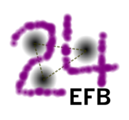Speaker
Description
No published data for $\Lambda n$ scattering exist. A relativistic heavy-ion experiment [1] has suggested that a $\Lambda nn$ bound state has been seen. If that were the case, our knowledge of the $nn$ interaction would permit one to use that $\Lambda nn$ bound state energy to generate strong constraints on the $\Lambda n$ interaction. JLab would be an ideal facility to obtain such data using the $^3$H(e,e'K$^+$)$^3_\Lambda$n reaction. However, at least four theoretical analyses based on a pairwise $nn$ and $\Lambda n$ interaction hypothesis have cast serious doubt on the bound-state assertion [2-5]. However, there could exist a three-body $\Lambda nn$ resonance. Such a resonance could be used to constrain the $\Lambda n$ interaction.
We discuss calculations for the $\Lambda nn$ system using pairwise interactions of rank-one, separable form that fit effective range parameters of the $nn$ system and those hypothesized for the as yet unobserved $\Lambda n$ system based upon two different Nijmegen one-boson exchange potentials [6,7], a J\"{u}lich one-boson exchange potential [8] and a chiral $\Lambda N$ potential [9], each of which is fit the known $\Lambda p$ scattering data. The use of rank-one separable potentials allows us to analytically continue the $\Lambda nn$ Faddeev equations into the second complex energy plane in search of resonance poles, by examining the eigenvalue spectrum of the kernel of the Faddeev equations.
Although none of the potential models utilized (each based upon the nominal $\Lambda p$ scattering length and effective range) predict a physical resonance pole, scaling of the $\Lambda n$ interaction by as little as $\sim$5\% (well within the $\Lambda p$ scattering data uncertainties), does produce a resonance in the $\Lambda nn$ system. This suggests that one may use photo (electro) production of the $\Lambda nn$ system as a tool to examine the strength of the $\Lambda n$ interaction. In particular, an experiment using K$^+$ electro production from tritium at Jefferson Lab has been performed in an effort to explore the $\Lambda nn$ final state (physical resonance or sub-threshold resonance); modeling the position and width of the spectrum would provide significant constraints on the scattering length and effective range of the heretofore unmeasured $\Lambda n$ interaction.
- C. Rappold, {et al.}, "Search for evidence of $^3_\Lambda n$ by observing $d+\pi^-$ and $t+\pi^-$ final states in the reaction of $^6$Li$+^{12}$C at $2A$ GeV", Phys. Rev. C {88}, 041001(R) (2013).
- H. Garcilazo, and A.Valcarce, "Nonexistance of a $\Lambda nn$ bound state", Phys. Rev. C {89}, 057001 (2014).
- E. Hiyama, S. Ohnishi, B. F. Gibson, and Th. A. Rijken, "Three-body structure of the
$nn\Lambda$ system with $\Lambda N-\Sigma N$ coupling", Phys. Rev. C {89}, 061302(R) (2014). - A. Gal, and H. Garcilazo, "Is there a bound $^3_\Lambda$n?", Phys. Lett. {B736}, 93 (2014).
- I. R. Afnan and B. F. Gibson, "Resonances in the $\Lambda$n System", Phys. Rev. C. {92}, 054608 (2015).
- M. M. Nagels, T. A. Rijken, and J. J. de Swart, "Baryon-baryon scattering in a one-boson-exchange-potential approach, II. Hypron-nucleon scattering", Phys, Rev. D {15}, 2547 (1977).
- T. A. Rijken, V. G. J. Stoks, Y. Yamamoto, "Soft-core hypron-nucleon potentials", Phys. Rev. C {59}, 21 (1999).
- J. Haidenbauer and Ulf-G. Mei\ss ner, "J\"ulich hypron-nucleon model revisited", Phys. Rev. C {72}, 044005 (2005).
- J. Haidenbauer, {et al.}, "Hypron-nucleon interaction at next-to-leading order in chiral effective field theory", Nucl. Phys. A {915}, 24 (2013).

